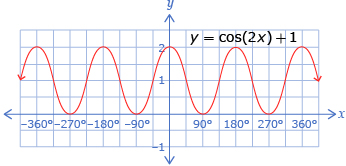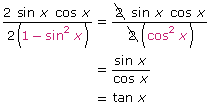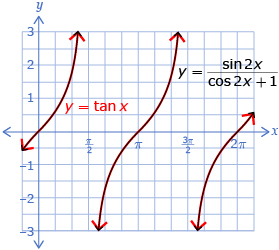Module 5: Lesson 4
Self-Check 2
- “Your Turn” from “Example 3” on page 303 of the textbook
- The expression
 indicates that the there will be restrictions when the denominator is equal to 0. This will occur when cos 2x + 1 = 0. At this point, it is likely that you will find it easy to solve this equation algebraically. Looking at the graph, however, should indicate where the non-permissible values will be.
indicates that the there will be restrictions when the denominator is equal to 0. This will occur when cos 2x + 1 = 0. At this point, it is likely that you will find it easy to solve this equation algebraically. Looking at the graph, however, should indicate where the non-permissible values will be.

From the graph, you should be able to see that …, −270°, −90°, 90°, 270°, … are non-permissible values. Writing this in general form gives {x|x ≠ 90° + n180°, n ∈ I, x ∈ R}.
-
By using the double-angle identities, the equation can be rewritten as follows:

By using cos2 x = 1 − sin2 x, the denominator can be rearranged as follows:

From here, the denominator can be simplified as follows:

At this point, the same trigonometric identity, cos2 x = 1 − sin2 x, can be used again, but in reverse. Then the expression can be simplified.

-
The graphical verification is shown.

Because the two graphs are superimposed on top of one another, it appears as though the two graphs are identical.
- The expression
© 2012 Alberta Education